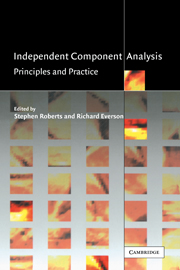Book contents
- Frontmatter
- Contents
- Preface
- Contributors
- 1 Introduction
- 2 Fast ICA by a fixed-point algorithm that maximizes non-Gaussianity
- 3 ICA, graphical models and variational methods
- 4 Nonlinear ICA
- 5 Separation of non-stationary natural signals
- 6 Separation of non-stationary sources: algorithms and performance
- 7 Blind source separation by sparse decomposition in a signal dictionary
- 8 Ensemble Learning for blind source separation
- 9 Image processing methods using ICA mixture models
- 10 Latent class and trait models for data classification and visualisation
- 11 Particle filters for non-stationary ICA
- 12 ICA: model order selection and dynamic source models
- References
- Index
9 - Image processing methods using ICA mixture models
Published online by Cambridge University Press: 05 July 2014
- Frontmatter
- Contents
- Preface
- Contributors
- 1 Introduction
- 2 Fast ICA by a fixed-point algorithm that maximizes non-Gaussianity
- 3 ICA, graphical models and variational methods
- 4 Nonlinear ICA
- 5 Separation of non-stationary natural signals
- 6 Separation of non-stationary sources: algorithms and performance
- 7 Blind source separation by sparse decomposition in a signal dictionary
- 8 Ensemble Learning for blind source separation
- 9 Image processing methods using ICA mixture models
- 10 Latent class and trait models for data classification and visualisation
- 11 Particle filters for non-stationary ICA
- 12 ICA: model order selection and dynamic source models
- References
- Index
Summary
An unsupervised classification algorithm is derived by modelling observed data as a mixture of several mutually exclusive classes that are each described by linear combinations of independent, non-Gaussian densities. The algorithm estimates the density of each class and is able to model class distributions with non-Gaussian structure. It can improve classification accuracy compared with standard Gaussian mixture models. When applied to images, the algorithm can learn efficient codes (basis functions) for images that capture the statistical structure of the images. We applied this method to the problem of unsupervised classification, segmentation and de-noising of images. This method was effective in classifying complex image textures such as trees and rocks in natural scenes. It was also useful for de-noising and filling in missing pixels in images with complex structures. The advantage of this model is that image codes can be learned with increasing numbers of classes thus providing greater flexibility in modelling structure and in finding more image features than in either Gaussian mixture models or standard ICA algorithms.
Introduction
Recently, Blind Source Separation by Independent Component Analysis has been applied to signal processing problems including speech enhancement, telecommunications and medical signal processing. ICA finds a linear non-orthogonal coordinate system in multivariate data determined by second- and higher-order statistics. The goal of ICA is to linearly transform the data in such a way that the transformed variables are as statistically independent from each other as possible [Jutten & Herault, 1991, Comon, 1994, Bell & Sejnowski, 1995, Cardoso & Laheld, 1996, Lee et al., 2000b]. ICA generalizes the technique of Principal Component Analysis (PCA) and, like PCA, has proven a useful tool for finding structure in data.
- Type
- Chapter
- Information
- Independent Component AnalysisPrinciples and Practice, pp. 234 - 253Publisher: Cambridge University PressPrint publication year: 2001
- 3
- Cited by

